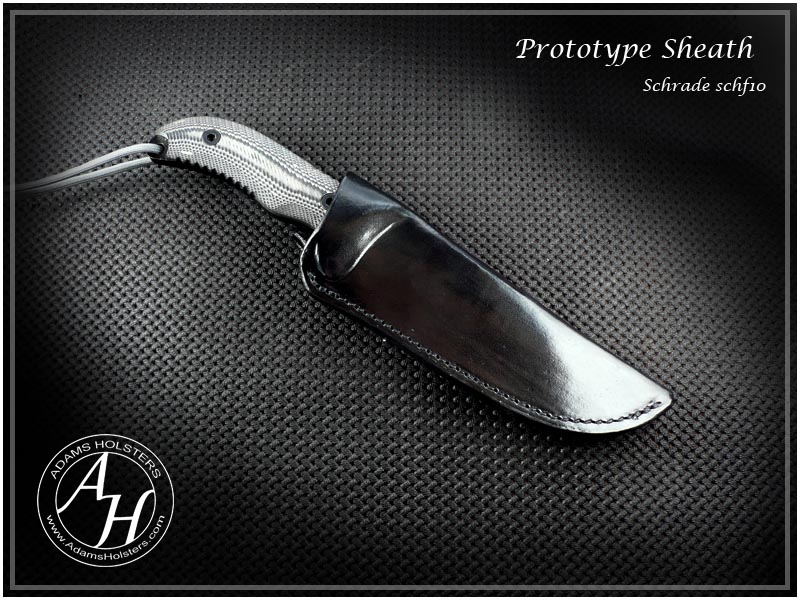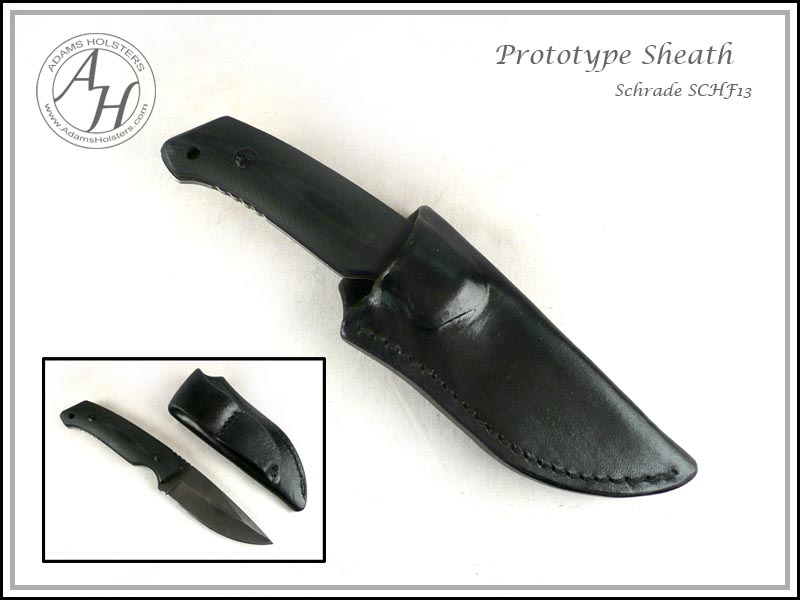So lately Schrade has been making big waves in the affordable knife field, and the three blades that have been the most anticipated by bushcraft enthusiasts is the Frontier series, the Schf-36, 37, and 38. I know, I absolutely detest Schrade's numbering system, too. However, I wanted to see if Schrade could produce a good, full tang, carbon steel survival knife that would be absolutely reliable and tough in the field.
I decided to get the first two knives in the series since those are the ones that interest me the most. The Schf-36 and 37 showed up on Friday, and I finally got a chance to evaluate the blades today. What first struck me about the Frontier knives is that they're obviously inspired by and intended to compete with the Becker line. The Schrades are different from the Beckers, but are actually improved upon in a couple of ways. The Schf-36 is a re-imagining of the BK-2 Campanion, and the Schf-37 is a drop-point redesign of the Becker BK-7 Combat Utility.
The black finish is a powder coat that feels similar to the traction coating put on Beckers, Esee's, TOPS, ect, but is nowhere near as tough. The finish wears off pretty quickly, which is not a bad thing. You don't really want a "traction" coating on a bush knife anyway. Friction is a bad thing when chopping or batoning, so I'll be removing the finish from my Frontiers as soon as possible.
The Frontier-series knives, unlike the 8cr13mov stainless Schrade builds most of their other knives from, are made of good old 1095 carbon steel, the same as Becker, Esee, TOPS, Ontario, ect. As far as I can tell, the blades are perfectly heat treated and good to go, quality-wise. The edges hold up very well, almost, if not as good, as the Beckers. Since I strop as I'm going, I couldn't tell the difference in edge retention between the two brands.
Here they are next to their Becker cousins for you guys who like pics.
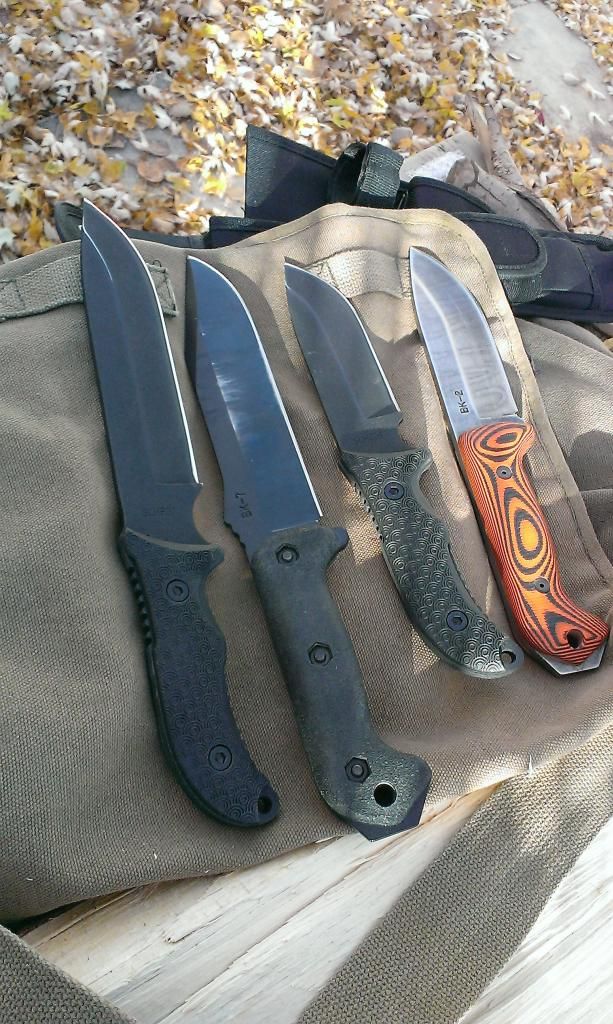
First up is the Schf-36.
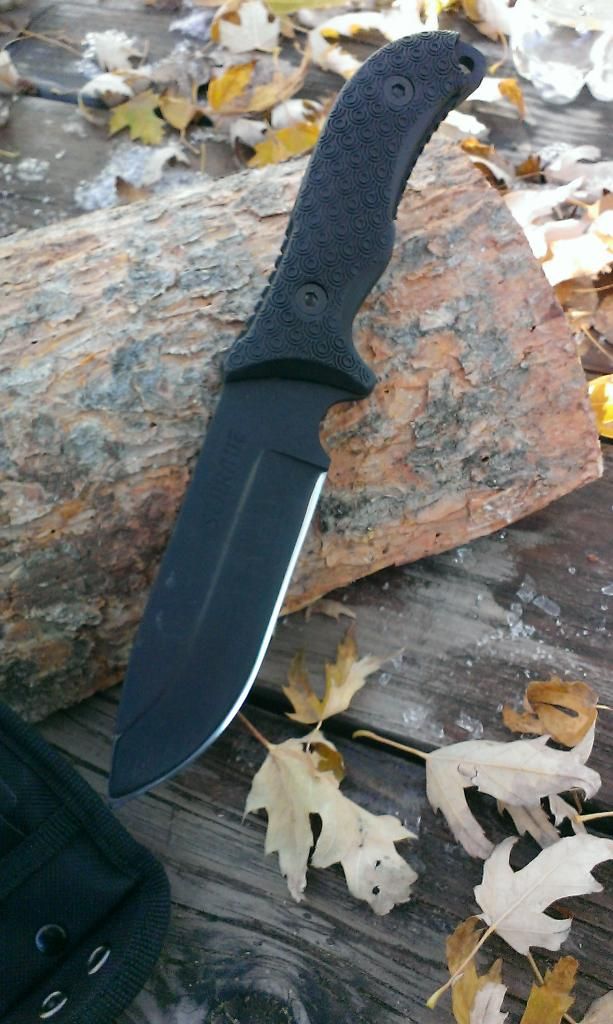
Like I said before, the 36 is very similar to the BK-2. In fact, if you lay the knives on top of each other the blades have almost the same dimensions. The big difference is the curved handle and the choil. Now, I've been wanting to add a choil to my BK-2 pretty much since I got it, but never got around to grinding one in. However, after using the 36 I can say that a choil is a great addition to the design. It brings the hand up into the middle of the knife and gives you a lot more control and balance while you're carving wood.
First, I batoned some wood off a piece of firewood and then did some feathersticks with the 36, and it does a fantastic job, slicing very fine curls easily. Batoning proved to be no problem, either. The nearly 1/4" thick blade can take a hell of a beating. It can chop, too, although you'll have to add a lanyard to wrap around your wrist so you can choke down on the handle to get more leverage. I denuded a tree branch of its twigs, even thick ones, with only a hit or two each. This would be a fine knife for constructing shelters or building fires in an emergency.
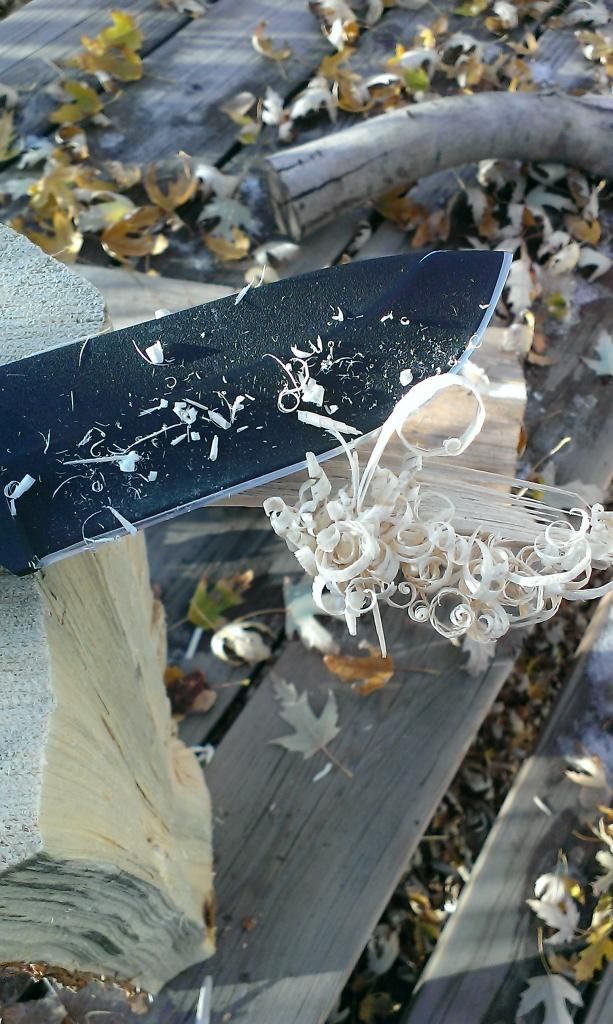
Who says you can't do bushcraft with a sharpened pry bar-type survival knife?
Next up is the Schf-37.
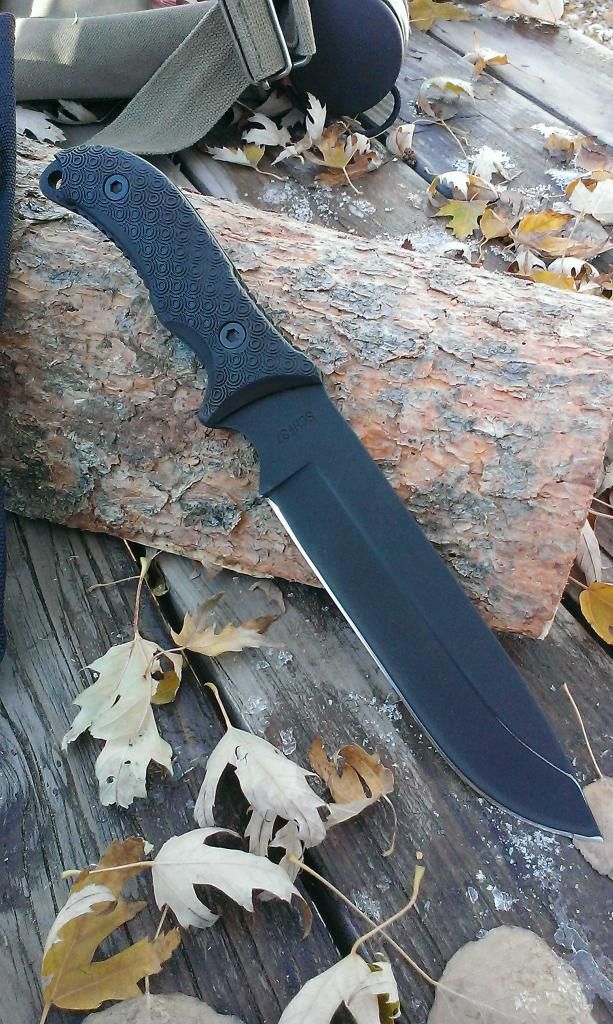
Basically, it's a drop point, 1/4" thick BK-7 with a choil, which is just fine with me. Chopping and batoning is this beast of a knife's forte, and it does it's job well. I processed a log into kindling with this bad boy, and it went through the seasoned pine with not a single problem. The thicker, heavier blade made the knife baton and chop better than its BK-7 cousin, which is intended more as a fighter than a bush knife. It made good curls for feathersticks, but I still need to dial the edge in a bit more before I'll be perfectly satisfied with its carving performance. Like with the 36, the choil is a great addition to the design, and I'll be adding one to my BK-7 in the future as well.
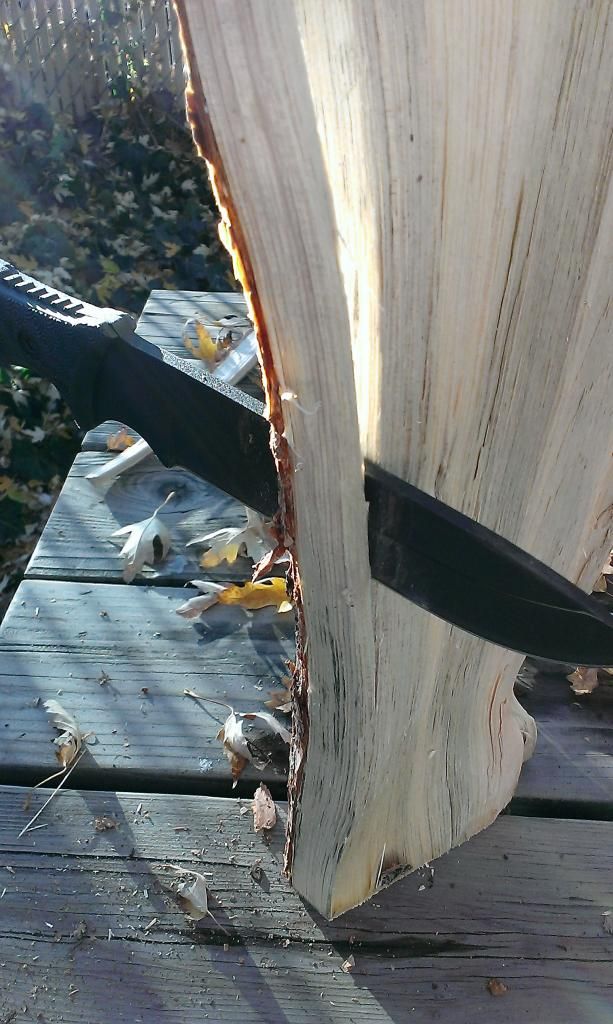
I convexed both knives as soon as I got them, and the edges on both held up perfectly well. The Schf-36, in addition to the high-relief convex, received a v-ground secondary bevel, since I anticipated carving more with it than the 37, which was only convexed for chopping and batoning performance. Both knives were still really sharp after I used them, and only required stropping on a block strop with black, green, and white buffing compound to make them hair-popping sharp (no exaggeration) and cut serpents in phone book paper.
The sheaths are pretty decent. Similar to the old-style Becker sheaths, they are made of cordura, with a retaining strap in the right place and a pouch to hold the diamond hone and firesteel that come with the knives! These were both great additions to the knife package, adn I'm glad Schrade threw them in.
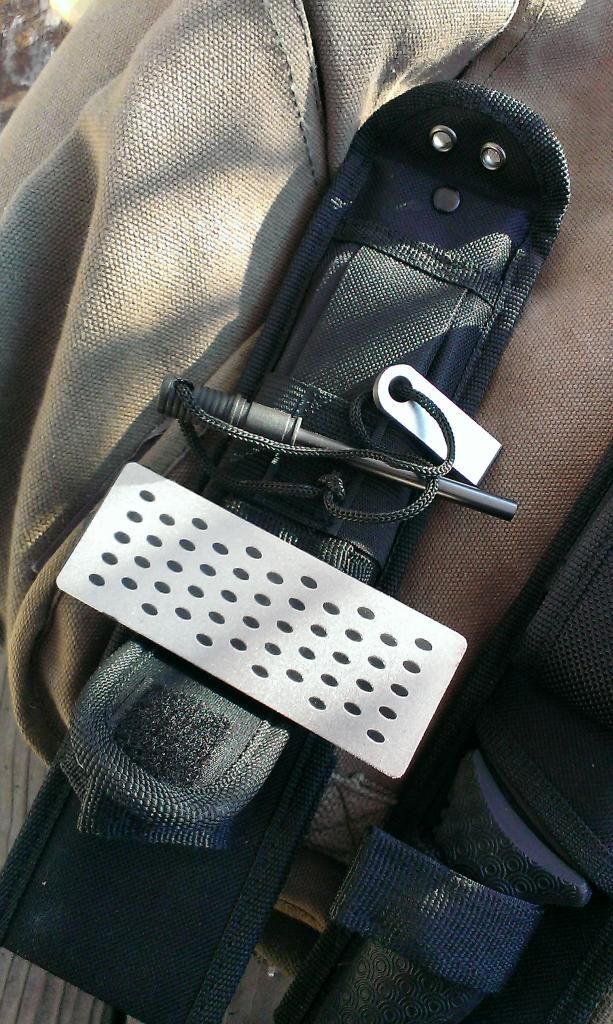
The curved handles are a great idea, and the TPE material is firm, but not squishy, and won't cause blisters like I thought it would. the curving handle gives added leverage and power to snap cuts. The scales are a little thin for my extra-large hands, but since I'd planned on replacing the scales with contoured, custom micarta, the point is moot.
Which brings me to the only drawback I found with the knives. There are two sections of jimping on the tang that are absolutely an abomination, as far as I'm concerned. I don't know who the idiot at Schrade was who thought, "Hey, let's add jimping you could file metal with to the damned handles, that'll show 'em!" but the a-hole needs to be dragged out into the street and put in the stocks for all to throw rotten vegetables at and mock. Those two sections of jimping are perfect for generating hot spots and blisters during extended use.
The jimping is square-cut and protrudes annoyingly, with sharp edges that need to be either rounded off or removed. You could wrap the knife's handle with tennis racket tape, which is going to be my solution until I put new scales on. The new scales I make will actually be in line with the apex of the jimping humps, and I'm going to round off the jimping as well, which should eliminate the problem. I'm going to send Schrade a review of their knives and recommend removing the jimping. They're usually really good about fixing problems, and I'm betting this will be a big one with every single bushcrafter out there. Jimping is a good idea on a combat knife, but a terrible idea for a bush knife.
Also, wear leather gloves when you use these knives. It minimized the jimping issue pretty well.
All in all, these are great knives. I'll be getting the Schf-38 now, since I want to round out the collection, and I'm already thinking about the mods I'm going to do to all three knives. You won't find a better deal in survival knives. I got my Schf-36 for $32, and the Schf-37 for $35. No better deal exists.
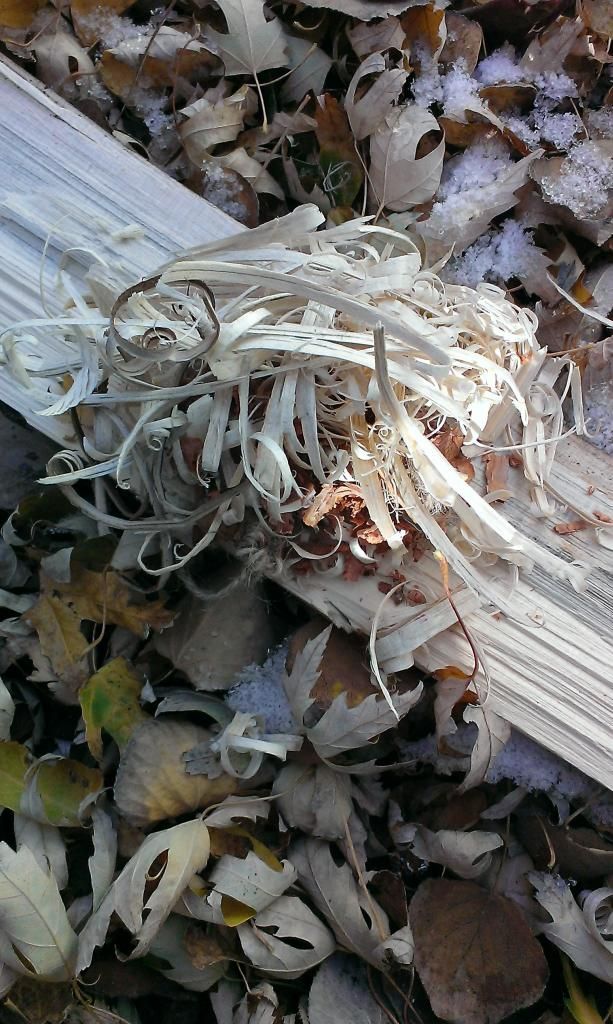
After I processed the log with both knives, I used the 36 to make a shingle for my base board, piled a length of pulled-apart and fluffed jute twine (always kept in my fire kit) and my shavings onto the board, and hit it with my firesteel. Success. My fire was thankfully hot in the 27 degree weather, and I spent the next three hours kicking back by the fire, warming my feet, writing, and eventually cooking a steak over the coals. All brought to me by these badass new survival knives.
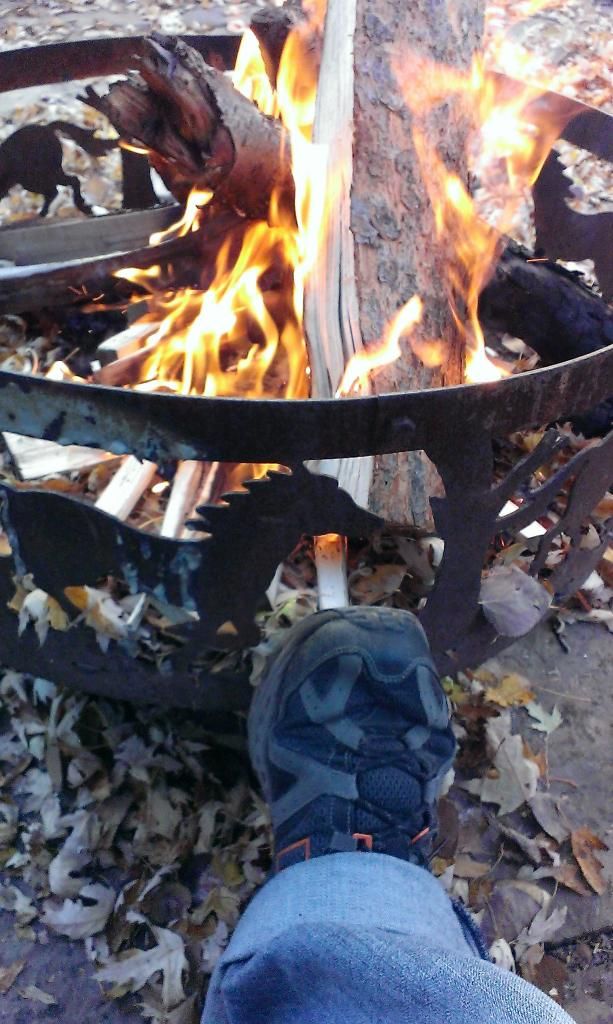
Go ahead, order one or two of the Schrade Frontier knives. You'll be happy you did.
I decided to get the first two knives in the series since those are the ones that interest me the most. The Schf-36 and 37 showed up on Friday, and I finally got a chance to evaluate the blades today. What first struck me about the Frontier knives is that they're obviously inspired by and intended to compete with the Becker line. The Schrades are different from the Beckers, but are actually improved upon in a couple of ways. The Schf-36 is a re-imagining of the BK-2 Campanion, and the Schf-37 is a drop-point redesign of the Becker BK-7 Combat Utility.
The black finish is a powder coat that feels similar to the traction coating put on Beckers, Esee's, TOPS, ect, but is nowhere near as tough. The finish wears off pretty quickly, which is not a bad thing. You don't really want a "traction" coating on a bush knife anyway. Friction is a bad thing when chopping or batoning, so I'll be removing the finish from my Frontiers as soon as possible.
The Frontier-series knives, unlike the 8cr13mov stainless Schrade builds most of their other knives from, are made of good old 1095 carbon steel, the same as Becker, Esee, TOPS, Ontario, ect. As far as I can tell, the blades are perfectly heat treated and good to go, quality-wise. The edges hold up very well, almost, if not as good, as the Beckers. Since I strop as I'm going, I couldn't tell the difference in edge retention between the two brands.
Here they are next to their Becker cousins for you guys who like pics.

First up is the Schf-36.

Like I said before, the 36 is very similar to the BK-2. In fact, if you lay the knives on top of each other the blades have almost the same dimensions. The big difference is the curved handle and the choil. Now, I've been wanting to add a choil to my BK-2 pretty much since I got it, but never got around to grinding one in. However, after using the 36 I can say that a choil is a great addition to the design. It brings the hand up into the middle of the knife and gives you a lot more control and balance while you're carving wood.
First, I batoned some wood off a piece of firewood and then did some feathersticks with the 36, and it does a fantastic job, slicing very fine curls easily. Batoning proved to be no problem, either. The nearly 1/4" thick blade can take a hell of a beating. It can chop, too, although you'll have to add a lanyard to wrap around your wrist so you can choke down on the handle to get more leverage. I denuded a tree branch of its twigs, even thick ones, with only a hit or two each. This would be a fine knife for constructing shelters or building fires in an emergency.

Who says you can't do bushcraft with a sharpened pry bar-type survival knife?
Next up is the Schf-37.

Basically, it's a drop point, 1/4" thick BK-7 with a choil, which is just fine with me. Chopping and batoning is this beast of a knife's forte, and it does it's job well. I processed a log into kindling with this bad boy, and it went through the seasoned pine with not a single problem. The thicker, heavier blade made the knife baton and chop better than its BK-7 cousin, which is intended more as a fighter than a bush knife. It made good curls for feathersticks, but I still need to dial the edge in a bit more before I'll be perfectly satisfied with its carving performance. Like with the 36, the choil is a great addition to the design, and I'll be adding one to my BK-7 in the future as well.

I convexed both knives as soon as I got them, and the edges on both held up perfectly well. The Schf-36, in addition to the high-relief convex, received a v-ground secondary bevel, since I anticipated carving more with it than the 37, which was only convexed for chopping and batoning performance. Both knives were still really sharp after I used them, and only required stropping on a block strop with black, green, and white buffing compound to make them hair-popping sharp (no exaggeration) and cut serpents in phone book paper.
The sheaths are pretty decent. Similar to the old-style Becker sheaths, they are made of cordura, with a retaining strap in the right place and a pouch to hold the diamond hone and firesteel that come with the knives! These were both great additions to the knife package, adn I'm glad Schrade threw them in.

The curved handles are a great idea, and the TPE material is firm, but not squishy, and won't cause blisters like I thought it would. the curving handle gives added leverage and power to snap cuts. The scales are a little thin for my extra-large hands, but since I'd planned on replacing the scales with contoured, custom micarta, the point is moot.
Which brings me to the only drawback I found with the knives. There are two sections of jimping on the tang that are absolutely an abomination, as far as I'm concerned. I don't know who the idiot at Schrade was who thought, "Hey, let's add jimping you could file metal with to the damned handles, that'll show 'em!" but the a-hole needs to be dragged out into the street and put in the stocks for all to throw rotten vegetables at and mock. Those two sections of jimping are perfect for generating hot spots and blisters during extended use.
The jimping is square-cut and protrudes annoyingly, with sharp edges that need to be either rounded off or removed. You could wrap the knife's handle with tennis racket tape, which is going to be my solution until I put new scales on. The new scales I make will actually be in line with the apex of the jimping humps, and I'm going to round off the jimping as well, which should eliminate the problem. I'm going to send Schrade a review of their knives and recommend removing the jimping. They're usually really good about fixing problems, and I'm betting this will be a big one with every single bushcrafter out there. Jimping is a good idea on a combat knife, but a terrible idea for a bush knife.
Also, wear leather gloves when you use these knives. It minimized the jimping issue pretty well.
All in all, these are great knives. I'll be getting the Schf-38 now, since I want to round out the collection, and I'm already thinking about the mods I'm going to do to all three knives. You won't find a better deal in survival knives. I got my Schf-36 for $32, and the Schf-37 for $35. No better deal exists.

After I processed the log with both knives, I used the 36 to make a shingle for my base board, piled a length of pulled-apart and fluffed jute twine (always kept in my fire kit) and my shavings onto the board, and hit it with my firesteel. Success. My fire was thankfully hot in the 27 degree weather, and I spent the next three hours kicking back by the fire, warming my feet, writing, and eventually cooking a steak over the coals. All brought to me by these badass new survival knives.

Go ahead, order one or two of the Schrade Frontier knives. You'll be happy you did.



